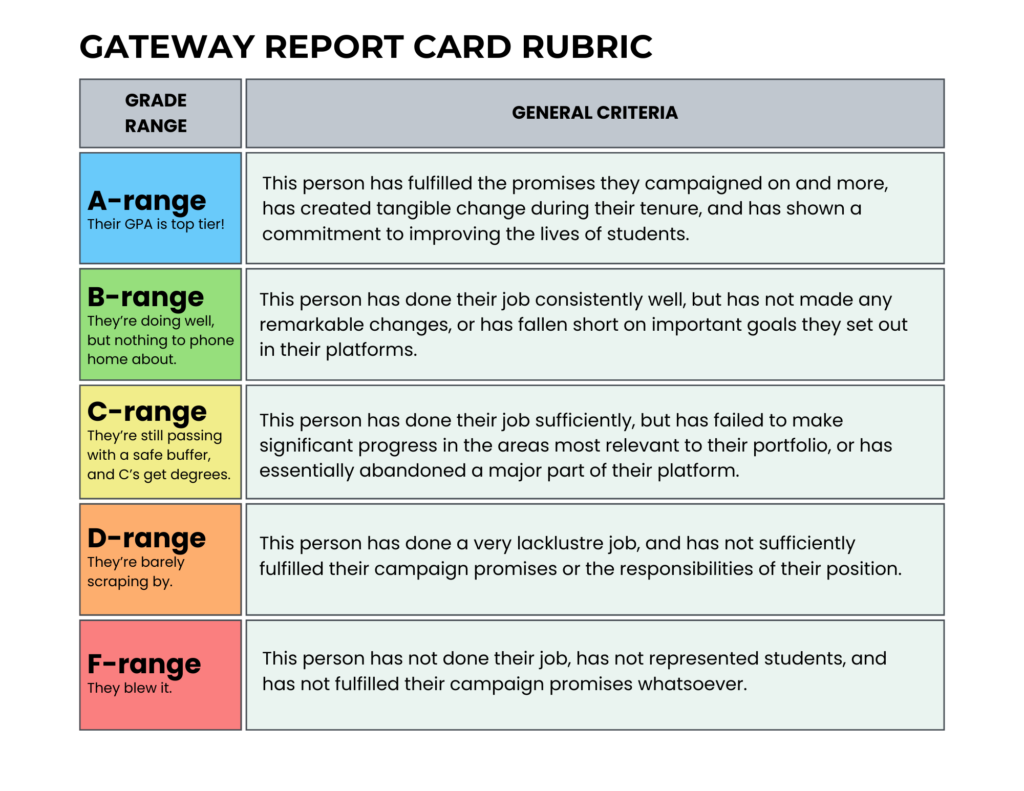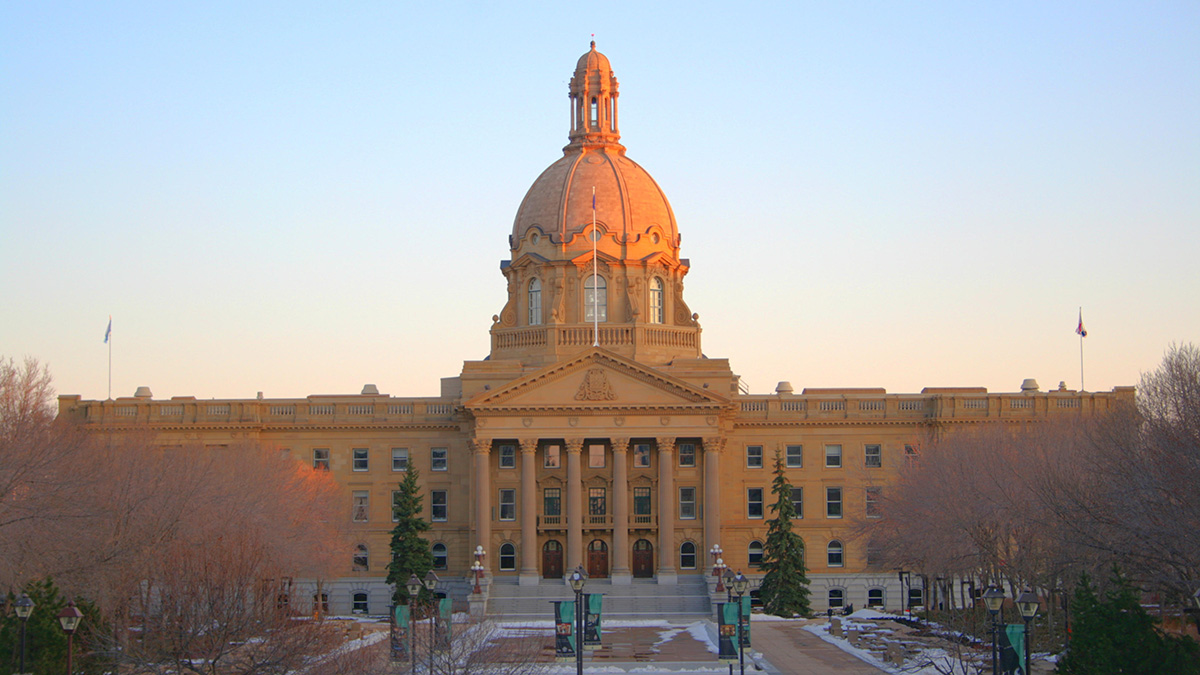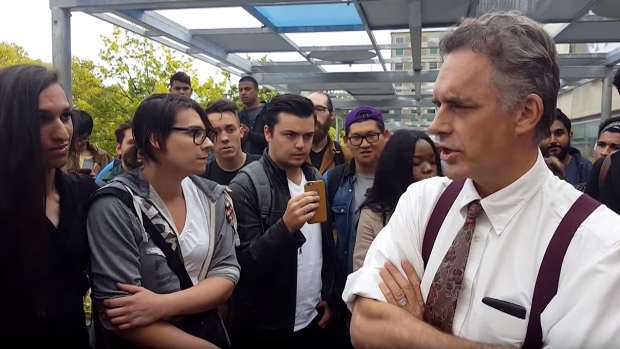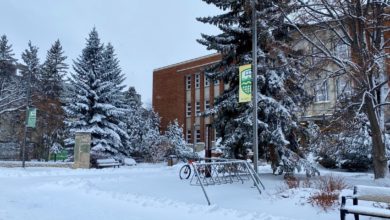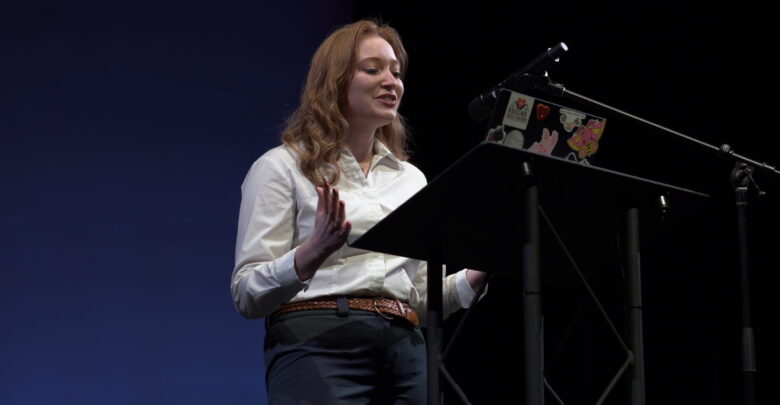 Lily Polenchuk
Lily Polenchuk Each year, The Gateway publishes an evaluation of the Students’ Union Executive and the Board of Governors representative. It’s impossible to discuss every aspect of their tenures, so these reports are largely based on the major components of the platform each executive campaigned on, and the most significant responsibilities of their respective positions. The grading rubric can be found at the bottom of the article.
And if you’re short for time, check out our TL;DR for a bite-sized breakdown.
Lisa Glock: D
For the University of Alberta Students’ Union (UASU), the president not only serves as a figurehead, but is often a guiding force for the executive team. They collaborate with the other UASU executives, councillors, and potentially even university administrators. The president sits on the General Faculties Council (GFC) and the Board of Governors (BoG). It’s a demanding job to say the least, and unfortunately, this year’s president, Lisa Glock, did not meet those demands. Her leadership, advocacy, and accomplishments leave much to be desired.
Lack of leadership on mental health, some progress on sexual and gender-based violence
To Glock’s credit, the UASU has made some progress in regards to mental health supports and gender equity issues. In our interview, I asked Glock what work she’s done to support students as they face rising tuition. Glock emphasized the importance of student well-being, especially around mental health. She said the UASU was able to bring in therapy bunnies, which students had previously requested.
However, in the grand scheme of things, therapy bunnies can only do so much. Petting a bunny, while nice, isn’t going to make tuition less expensive. Bunnies also are not a robust mental health support. It’s a nice perk to have on campus, but relatively minor.
Glock admitted Renson Alva, the UASU’s vice-president (student life) (VPSL), largely led this initiative. So while she seemed to be proud of this, she can’t take much credit for it. I would have liked to see Glock take more initiative with student issues rather than deferring to her executives. Showing leadership not just through collaboration but also the advancement of her own goals is important. Unfortunately, there just wasn’t a good balance between the two.
When I asked Glock about her work on sexual and gender-based violence (SGBV), she was able to tell me two specific things she did. The first was a motion she brought forward to the Council Administration Committee (CAC) to recommend members of Students’ Council become certified as Gender-Based Analysis Plus (GBA Plus).
Taking steps to educate student representatives on SGBV is a good idea. However, GBA Plus doesn’t seem to be the best option to do this. According to the Government of Canada’s website, GBA Plus is a tool the federal government uses to “support the development of responsive and inclusive policies, programs, and other initiatives.” The certification seems to focus on education around the effect GBA Plus has on the federal government’s initiatives. This isn’t a bad thing to be aware of, but it doesn’t seem like the best fit for student leaders.
The other thing Glock has been working on is the Dean of Students (DoS) office’s privacy policy for students. In our interview, Glock said a student had told her the DoS had broken confidentiality. She’s been pushing for a privacy audit, which the DoS is currently undergoing, according to Glock.
This is an important step towards fixing issues with confidentiality. Violations of confidentiality not only compromise student privacy, but also may deter them from seeking support after a SGBV incident. However, I would have liked to see Glock do more on SGBV generally.
In 2023, a study commissioned by the Government of Alberta found that 64 per cent of U of A students had experienced SGBV since attending the U of A. That was higher than the provincial average of 43 per cent. Given the amount of students who have experienced SGBV, Glock should have been doing more to address this issue.
Promises to international students forgotten
Perhaps one of the biggest responsibilities the president takes on is handling tuition increases. This is largely because they sit on the BoG, which makes the final decision on tuition increases.
In October 2024, Rajan Sawhney, Alberta’s Minster of Advanced Education, rejected all proposals for exceptional tuition increases (ETI) for 2025–26. The UASU applauded the decision as it was “in line with [the UASU’s] ongoing advocacy about the cost of living and the affordability of high-quality education.” While this was a big win for students, the UASU can’t take all the credit. It’s likely several student associations across the province were asking for the same thing. As well, Sawhney could have rejected the ETIs for a reason having nothing to do with student advocacy.
But more importantly, no ETIs doesn’t mean no tuition increases. Domestic students may be facing another two per cent increase to their tuition, which would be the sixth consecutive tuition increase. The university is also proposing a 10 per cent increase to international students’ tuition for those who are admitted for the 2026–27 year.
Glock told me in our interview that the UASU has been advocating to the Ministry of Advanced Education for more funding to the U of A. Aside from that, she’s been working with Abdul Abbasi, the UASU vice-president (external) (VPX), for more work-integrated learning (WIL) opportunities. She said they’ve been trying to create a working group made up of industry partners and the government to look at this issue.
Glock emphasized the importance of students being able to get work experience while also receiving a fair wage. I couldn’t agree more. But a working group can only do so much, if it’s even formed. Glock also did not mention having students sit on the working group, which would be key in making sure WIL opportunities are fair to students.
On the international student front, Glock made several promises during the International Students’ Association’s (ISA) forum when she was campaigning for president. One of those was to get the ISA a seat on the Tuition Advisory Committee (TAC). When I asked Glock about this in our interview, she said she wasn’t able to do that. She said she made that promise without being familiar with how university governance works. But, she should have done her research before making that promise.
Additionally, during the same forum, Glock had expressed that she wanted to create a mailing list to keep students informed about issues international students are facing. Once again, Glock has not done this. She told me in our interview that the UASU’s shift from BearsDen to a new student group software would make it easier for groups to do something like creating a newsletter. But that’s not the same thing as doing it yourself.
Even if that was something Glock couldn’t reasonably do during her term, she could have done more to raise awareness around international student issues. There were other ways Glock could have done this if a mailing list didn’t work out. Whether that could have taken the form of a social media campaign or articles in The Flame, the UASU’s blog. But Glock didn’t take any of these routes.
Lack of leadership for student mobilization, despite campaign promises
Glock had campaigned on facilitating student protests, and I asked about this. While she thinks student protests are important, Glock said she hasn’t heard much interest in the UASU organizing one against tuition increases. She also pointed to the low student turnout at the protest outside of the BoG meeting where tuition was approved last year.
The UASU has had success with organizing student protests in the past, whether against tuition increases or provincial funding cuts. But the UASU hasn’t put much effort into organizing protests in a few years now. The lack of interest Glock referred to doesn’t make much sense to me. If the UASU hasn’t organized a protest in a few years, how can she gauge the interest? To my knowledge, there has been no surveys or consultation done on this.
The UASU did help organize the protest at the BoG meeting last year with the help of the Alberta Public Interest Research Group (APIRG). However, there was minimal effort put into it. Aside from a single Instagram post and providing hot chocolate, the UASU didn’t do a whole lot. So it’s no wonder the turnout was low, considering that APIRG has a much smaller reach and capacity for organizing protests compared to the UASU. Using that as an excuse to not organize student protests is a cop out.
Additionally, students have shown interest in other forms of student activism. The Canadian Alliance for Student Associations (CASA) led a mock-cheque signing effort to advocate for a permanent increase to the federal government’s student grants. According to Glock, the UASU was able to get the most students to sign cheques of any student association.
Clearly, when the UASU puts real effort into it, U of A students are willing and interested in taking part in advocacy efforts. So why Glock has written off organizing student protests is a mystery to me. Especially when Glock campaigned on facilitating protests.
Lack of awareness and initiative led to failures in addressing important issues
Glock noted minimizing the impact of tuition increases as a priority for her term when I interviewed her in August. Financial support is a big way to minimize those impacts, which Glock recognized in our interview. However, the UASU took far too long to address the delays with Alberta Student Aid (ASA). It took until the third week of September for the UASU to sign onto a joint letter asking for improvements to the system.
Additionally, Glock made no effort to increase student awareness of the changes to ASA eligibility. Students who drop down to part-time studies for two study terms after the first 30 days of a course while receiving financial aid become ineligible for student loans for 18 months. Other student associations put out press releases to students to raise awareness of this change.
From the UASU, students got nothing. When I asked Glock about this, she said the delays were her main concern. She also said she wasn’t “too sure about the communications [strategy].” As president, she should be proactive about informing students about these kinds of changes. Becoming ineligible for ASA for 18 months could be devastating for a student. Yet, the UASU made no effort to communicate that to students.
Being unsure about the “communications strategy” is not only disappointing but concerning. As head of the UASU, Glock could have used her position to spread awareness about these changes. And this isn’t a monumental thing to ask for — other student associations did it. It’s one thing to be unsure about the best communications strategy to take. It’s another thing completely to not try any strategy at all. Surely this is a challenge Glock could have gotten to the bottom of.
Lack of initiative on Glock’s part is also apparent in her handling of student’s safety concerns. I asked Glock about the significant safety concerns the Indigenous Students’ Union (ISU) had been dealing with. ISU President Sophie Martel recently presented to Students’ Council about these concerns after a student was assaulted in the ISU lounge. Glock acknowledged these concerns as important, but said that it fell into Alva’s portfolio more than hers. While this is true, Glock emphasized decolonizing the UASU and bringing Indigenous voices to the table during her campaign. To say now that it wasn’t directly in her portfolio is a poor way to avoid delivering on her promises. It also damages the relationship between the UASU and ISU, as Martel noted that executives have frequently failed to follow through on campaign promises.
Glock did say she called U of A President and Vice-chancellor Bill Flanagan after the assault to find out who to talk to for these concerns to be addressed. I can’t help but wonder where this urgency was in the months leading up to the assault. The ISU’s concerns were not a recent development. It should not have taken a student being physically assaulted for the university to address the ISU’s safety concerns. But it also shouldn’t have taken an assault to get either Alva or Glock to act with some urgency on the issue.
In the presentation to Students’ Council, the ISU also mentioned that no one had told them that they could attend Students’ Council, GFC, or BoG meetings. When I asked Glock about this, she once again said she wasn’t sure why that hadn’t been communicated to the ISU. For someone who talks about bringing Indigenous voices to the table, you’d think inviting them to these meetings would be the first step. But yet again, a lack of initiative resulted in Glock underdelivering on her promises.
Glock’s approach to international student issues, tuition increases, student aid delays, and student safety has revealed a chronic lack of initiative. While her executive team has led initiatives and made some progress, Glock was ultimately only able to point to a few of her own initiatives, resulting in a D grade.
TL;DR: Glock was able to make some progress on SGBV and helped students avoid ETIs. But she showed a distinct lack of initiative, and sometimes even awareness, when it came to students’ issues. Glock either ignored or took way too long to address financial aid issues, safety concerns, and several campaign promises.
